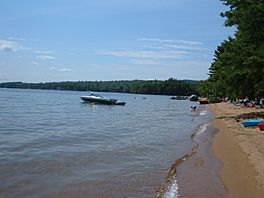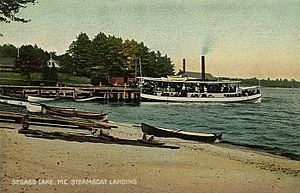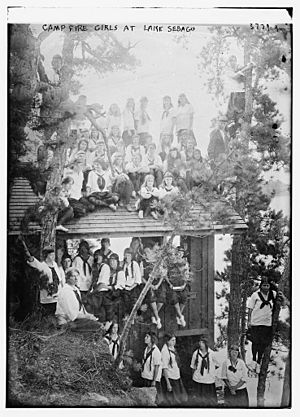Sebago Lake facts for kids
Quick facts for kids Sebago Lake |
|
|---|---|

A beach in Sebago Lake State Park
|
|
| Location | Cumberland County, Maine |
| Coordinates | 43°51′N 70°34′W / 43.850°N 70.567°W |
| Lake type | oligotrophic |
| Primary outflows | Presumpscot River |
| Catchment area | 440 square miles (1,100 km2) |
| Basin countries | United States |
| Max. length | 12 mi (19 km) |
| Surface area | 30,513 acres (12,348 ha) |
| Average depth | 107 ft (33 m) |
| Max. depth | 316 ft (96 m) |
| Water volume | 3,224,233 acre⋅ft (3.977033×109 m3) |
| Residence time | 5.1 to 5.4 yrs |
| Shore length1 | 105 miles (169 km) |
| Surface elevation | 267 ft (81 m) |
| Islands | Frye Island |
| Settlements | Casco, Naples, Raymond, Sebago, Standish and Windham |
| 1 Shore length is not a well-defined measure. | |
Sebago Lake is a very important lake in Maine, a state in the United States. It is the deepest lake in Maine and the second largest. The lake is about 316 feet (96 m) deep at its deepest point. On average, it is about 101 feet (31 m) deep.
Sebago Lake covers a large area, about 45 square miles (117 km2). It is also quite long, stretching about 14 miles (23 km). The shoreline around the lake is roughly 105 miles (169 km) long. The lake's surface is about 270 feet (82 m) above sea level. This means that the very bottom of the lake is actually below the current sea level.
The lake is located in Cumberland County. Several towns are right on its borders. These include Casco, Naples, Raymond, Sebago, Standish, and Windham. There is also an island in the lake called Frye Island. Many people live there during certain times of the year.
The weather around Sebago Lake can change very quickly. This is because it is close to the Atlantic Ocean. It is also near Mt. Washington, which is known for its extreme weather. The name "Sebago" comes from the Abenaki language. It means "big still water."
Contents
How People Travelled on Sebago Lake
Sebago Lake is connected to Brandy Pond by the Songo River. This river then leads to Long Lake in Naples. These lakes and rivers were once important travel routes. They helped people move goods and travel from the coast to inland areas. This encouraged the first European settlements in inland Maine in 1762.
In 1832, the Cumberland and Oxford Canal was built. This canal connected Sebago Lake to Portland harbor. It made it easier to transport things. Later, a railroad replaced the canal. The water flow from the lake into the Presumpscot River was controlled by dams. These dams were used by companies like the Oriental Powder Company and the S. D. Warren Paper Mill.
Planes and the Lake
During World War II, Sebago Lake was used for training military pilots. It was a safer place for them to practice flying over water. However, some navy planes were lost in the lake during this time. For example, a Grumman TBF Avenger plane sank in 1943. In 1944, two British Corsairs crashed after hitting each other. Another Corsair also crashed into the lake that year. In 2014, a small yellow plane landed on a Sebago Lake beach. Some people believe this was the first time a plane landed on the lake's beaches.
Sebago Lake's Water Supply
Sebago Lake is a very important source of drinking water. It provides water for the Portland Water District. This district serves the greater Portland area. About 20% of Maine's population gets its water from Sebago Lake.
The area that collects water for the lake is called its watershed. This watershed is over 50 miles (80 km) long. It covers parts of 24 towns in Maine. The lake holds a huge amount of water, about 995 billion US gallons (3.77×109 m3). On average, water stays in the lake for about 5.1 to 5.4 years.
Most of the watershed is covered by forests and fields. A smaller part is used for homes, farms, and businesses. About 24 million US gallons (91,000 m3) of water is taken from the lake each day for drinking.
Fun Things to Do at Sebago Lake
Sebago Lake is a popular place for recreation. In 1938, Maine opened Sebago Lake State Park. This was one of the state's first five parks. The park is about 1,400 acres (5.7 km2) in size and is mostly forested. It is open all year round. The park has places to launch boats and a large campground with 250 sites.
There are also many private campgrounds and cottages around the lake. For example, Point Sebago in Casco is a large private resort.
Even though there are public access points, it can be hard to get to the lake by land. Many parts of the shoreline are private property. This means they are not open to the public for recreation.
You can also learn to sail or rent a boat on Sebago Lake. The area is known as the Western Lakes and Mountains Region for tourism. There are plans to complete the Sebago to the Sea Trail. This trail will run 28 miles (45 km) from Sebago Lake to Casco Bay. It mostly follows the path of the Presumpscot River.
Fishing in Sebago Lake
Sebago Lake is famous for its landlocked salmon. These fish are even named after the lake in their scientific name, Salmo salar sebago. Long ago, the entire area was covered by seawater. As the land rose and the sea pulled back, these marine animals adapted to living in freshwater.
Other types of fish you can find in the lake include lake trout, brook trout, brown trout, largemouth bass, and northern pike. Some of these fish are put into the lake by the state. Others were brought in illegally. The state asks anglers to catch and report any northern pike they find. This is because northern pike are not native to the area. They could harm the lake's natural ecosystem and its original fish species, like the landlocked salmon.
Camps on Sebago Lake
Several camps are located on the shores of Sebago Lake, offering fun and learning experiences:
- Center Day Camp: This is a day camp run by the Jewish Community Alliance of Southern Maine.
- Camp O-At-Ka: Founded in 1906, this camp has a long stretch of waterfront in the northwest part of the lake.
- Camp Sebago: This camp is run by The Salvation Army and is located on the southwestern side of the lake.
- Camp Wohelo: This was the first camp for the Camp Fire Girls. It was started in 1907 by Luther Halsey Gulick and Charlotte Vetter Gulick. They wanted to teach young girls aged 6–16 about independence and outdoor skills. Wohelo is still active today.





